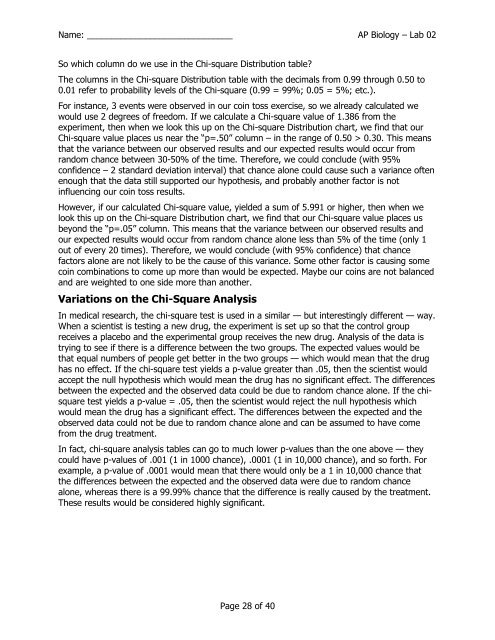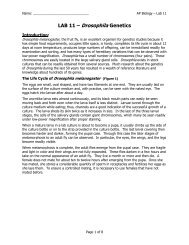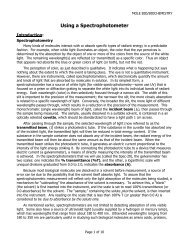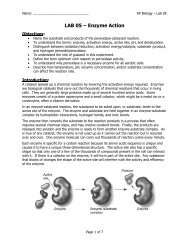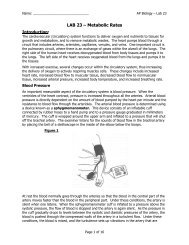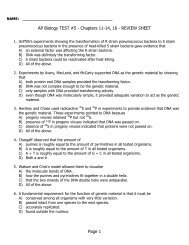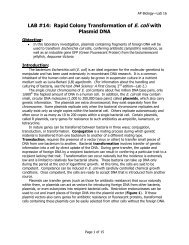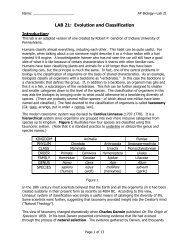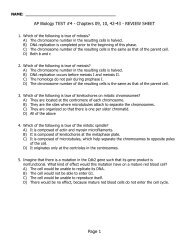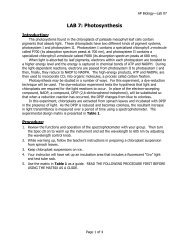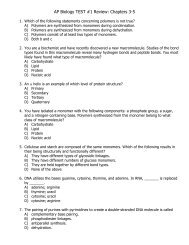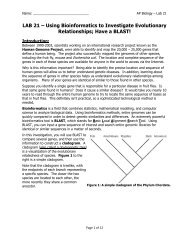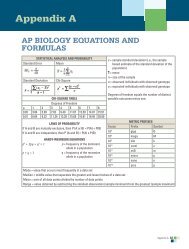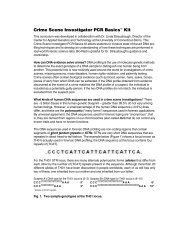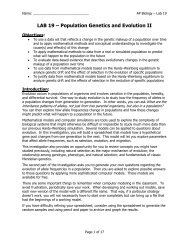AP Lab 02 - Biology Lab Skills
AP Lab 02 - Biology Lab Skills
AP Lab 02 - Biology Lab Skills
Create successful ePaper yourself
Turn your PDF publications into a flip-book with our unique Google optimized e-Paper software.
Name: ______________________________ <strong>AP</strong> <strong>Biology</strong> – <strong>Lab</strong> <strong>02</strong><br />
So which column do we use in the Chi-square Distribution table?<br />
The columns in the Chi-square Distribution table with the decimals from 0.99 through 0.50 to<br />
0.01 refer to probability levels of the Chi-square (0.99 = 99%; 0.05 = 5%; etc.).<br />
For instance, 3 events were observed in our coin toss exercise, so we already calculated we<br />
would use 2 degrees of freedom. If we calculate a Chi-square value of 1.386 from the<br />
experiment, then when we look this up on the Chi-square Distribution chart, we find that our<br />
Chi-square value places us near the ―p=.50‖ column – in the range of 0.50 > 0.30. This means<br />
that the variance between our observed results and our expected results would occur from<br />
random chance between 30-50% of the time. Therefore, we could conclude (with 95%<br />
confidence – 2 standard deviation interval) that chance alone could cause such a variance often<br />
enough that the data still supported our hypothesis, and probably another factor is not<br />
influencing our coin toss results.<br />
However, if our calculated Chi-square value, yielded a sum of 5.991 or higher, then when we<br />
look this up on the Chi-square Distribution chart, we find that our Chi-square value places us<br />
beyond the ―p=.05‖ column. This means that the variance between our observed results and<br />
our expected results would occur from random chance alone less than 5% of the time (only 1<br />
out of every 20 times). Therefore, we would conclude (with 95% confidence) that chance<br />
factors alone are not likely to be the cause of this variance. Some other factor is causing some<br />
coin combinations to come up more than would be expected. Maybe our coins are not balanced<br />
and are weighted to one side more than another.<br />
Variations on the Chi-Square Analysis<br />
In medical research, the chi-square test is used in a similar — but interestingly different — way.<br />
When a scientist is testing a new drug, the experiment is set up so that the control group<br />
receives a placebo and the experimental group receives the new drug. Analysis of the data is<br />
trying to see if there is a difference between the two groups. The expected values would be<br />
that equal numbers of people get better in the two groups — which would mean that the drug<br />
has no effect. If the chi-square test yields a p-value greater than .05, then the scientist would<br />
accept the null hypothesis which would mean the drug has no significant effect. The differences<br />
between the expected and the observed data could be due to random chance alone. If the chisquare<br />
test yields a p-value = .05, then the scientist would reject the null hypothesis which<br />
would mean the drug has a significant effect. The differences between the expected and the<br />
observed data could not be due to random chance alone and can be assumed to have come<br />
from the drug treatment.<br />
In fact, chi-square analysis tables can go to much lower p-values than the one above — they<br />
could have p-values of .001 (1 in 1000 chance), .0001 (1 in 10,000 chance), and so forth. For<br />
example, a p-value of .0001 would mean that there would only be a 1 in 10,000 chance that<br />
the differences between the expected and the observed data were due to random chance<br />
alone, whereas there is a 99.99% chance that the difference is really caused by the treatment.<br />
These results would be considered highly significant.<br />
Page 28 of 40


